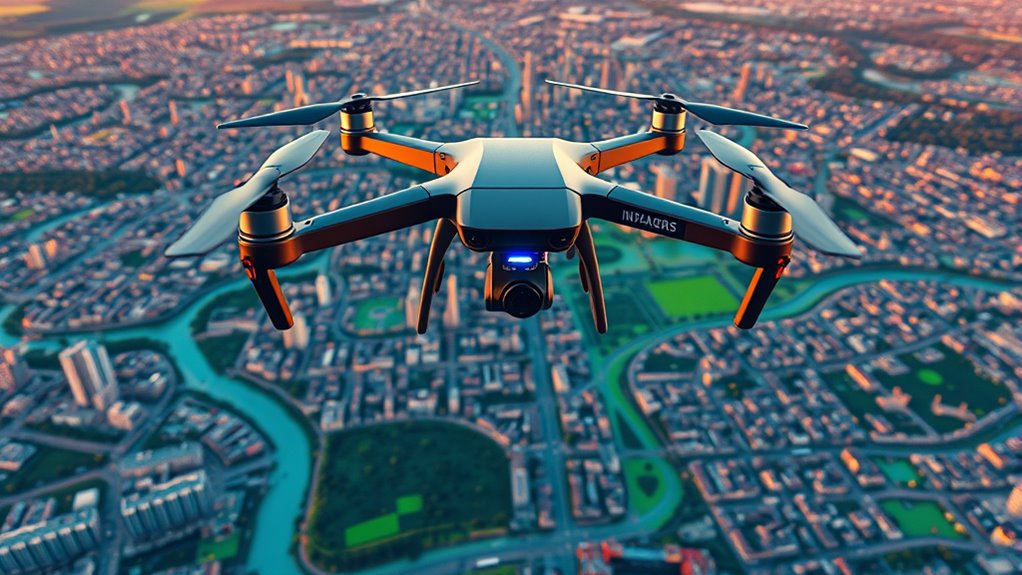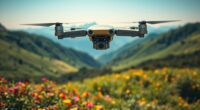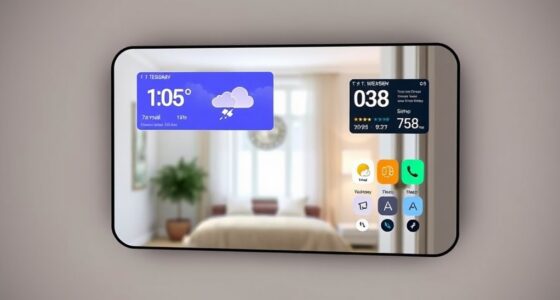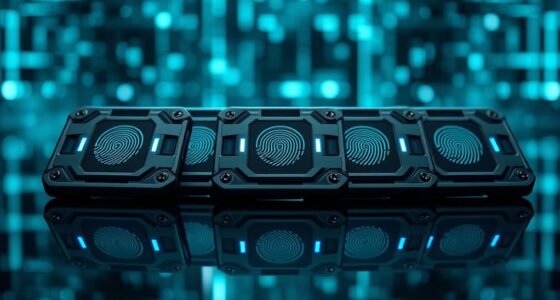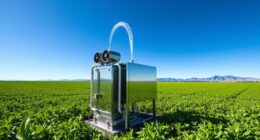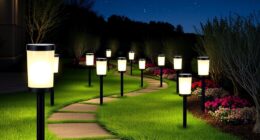If you’re looking for the best consumer drones with Lidar that are transforming aerial mapping in 2025, I’d recommend checking out models that combine compact, foldable designs with advanced sensors and high-precision cameras. Many of these drones feature GPS, long flight times, and smooth stabilization, perfect for detailed surveys. Smaller, lightweight options also avoid registration hassles and include smart safety features. Stick around—there’s plenty more to discover about these innovative mapping tools.
Key Takeaways
- Consumer drones with integrated LiDAR are enabling highly accurate, real-time 3D mapping and surveying for various industries.
- Compact, foldable LiDAR drones like G11PRO and N11 PRO enhance portability for outdoor and remote aerial mapping tasks.
- Advanced LiDAR-equipped drones feature extended flight times and stable navigation, improving data collection efficiency.
- User-friendly controls and autonomous flight modes make LiDAR drones accessible to both amateurs and professional surveyors.
- Integration of high-resolution cameras with LiDAR sensors enables detailed topographical and structural mapping in 2025.
K610 GPS Drone with Camera for Adults 4K IMX SENS Camera SD Card
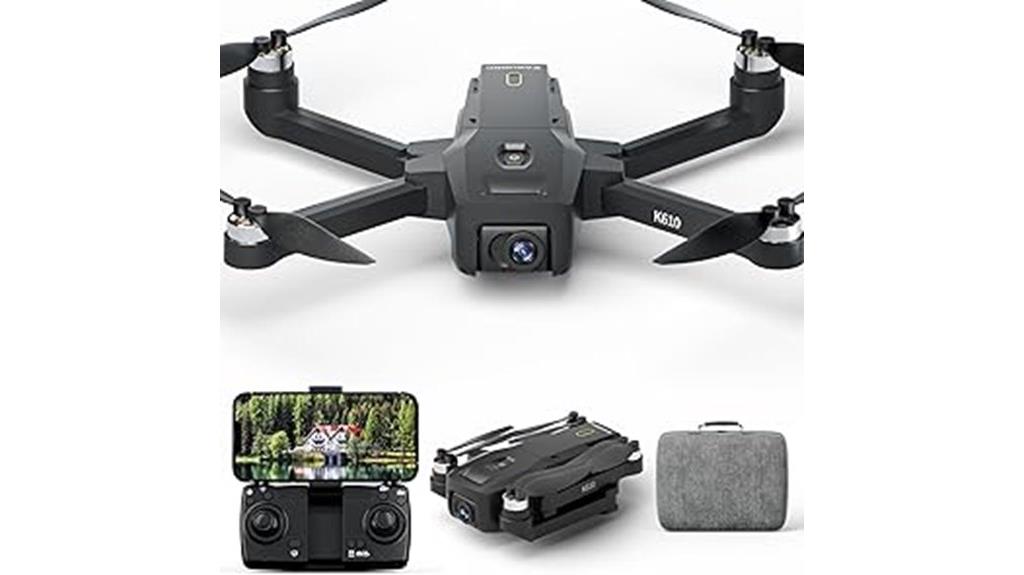
The K610 GPS Drone with Camera is an excellent choice for beginners and casual users who want a portable, easy-to-operate drone with high-quality imaging capabilities. Its lightweight, foldable design, weighing just 1.63 pounds, makes it perfect for travel. Equipped with a 4K IMX sensor camera and SD card support, it captures sharp photos and videos. With up to 11 minutes of flight time and advanced GPS features like Auto Return and Follow Me, it’s user-friendly yet feature-rich. Despite some connectivity quirks, its stability, quiet operation, and GPS-assisted functions make it ideal for outdoor adventures and casual aerial photography.
Best For: casual outdoor enthusiasts and beginners seeking a portable, easy-to-use drone with high-quality camera features.
Pros:
- Foldable, lightweight design enhances portability for travel and outdoor use
- Equipped with a 4K camera and SD card support for high-quality photos and videos
- User-friendly GPS features like Auto Return and Follow Me simplify flying and improve safety
Cons:
- Limited flight time of around 8–11 minutes per charge may require multiple batteries for extended use
- Connectivity issues may arise, making app pairing and control setup challenging for some users
- Lack of obstacle avoidance increases risk of collision in windy or cluttered environments
Potensic ATOM LT GPS Drone with 2.5K Camera and 40-Min Flight
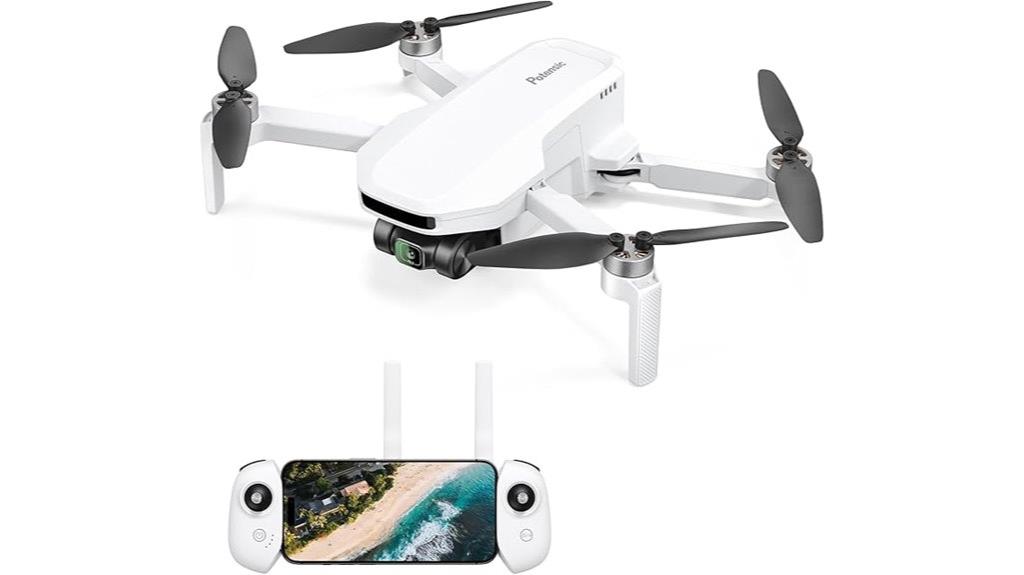
If you’re a beginner or casual flyer looking for a lightweight, portable drone with impressive flight time and a high-quality camera, the Potensic ATOM LT GPS Drone is an excellent choice. Weighing under 249g, it doesn’t require FAA registration, and its foldable design makes it easy to carry in a pocket. It offers up to 40 minutes of flight thanks to a 3000mAh battery and performs well in moderate wind speeds. The 2.5K camera with stabilization captures sharp photos and videos, while the HD transmission system maintains a reliable 4 km connection. Overall, it’s a user-friendly drone perfect for outdoor exploration and aerial filming.
Best For: beginners and casual flyers seeking a lightweight, portable drone with long flight time and high-quality camera for outdoor exploration.
Pros:
- Weighs under 249g, eliminating FAA registration requirements
- Up to 40 minutes of flight time with a 3000mAh battery
- 2.5K stabilized camera with adjustable tilt and reliable HD transmission up to 4 km
Cons:
- Occasional altitude glitches requiring manual control during landing
- No included carrying case or SD card, which are desirable accessories
- Slow GPS lock and some user reports of hard landings during automatic descent
N11 PRO GPS Drone with Camera (4K UHD, 90 Min Flight)

Are you looking for a compact drone that combines high-quality camera capabilities with impressive flight time? The N11 PRO GPS Drone fits the bill perfectly. Weighing under 0.55 pounds, it doesn’t require FAA registration, making it hassle-free to fly in the US. Its foldable design and lightweight build make it easy to carry, whether in a backpack or pocket. Equipped with alloy brushless motors, it handles wind well and offers a flight time of up to 90 minutes with three batteries. Its 4K UHD camera, GPS-assisted features, and stable live video streaming enable confident, professional-quality aerial footage. It’s a versatile, user-friendly drone for hobbyists and travelers alike.
Best For: hobbyists, travelers, and beginners seeking a portable, easy-to-use drone with high-quality camera features and long flight time.
Pros:
- Lightweight, foldable design for easy portability and outdoor travel
- Up to 90 minutes of total flight time with three batteries and stable GPS-assisted features
- 4K UHD camera with adjustable wide-angle lens and 5GHz FPV transmission for high-quality footage
Cons:
- Battery life per flight is around 6-8 minutes, requiring multiple batteries for extended use
- May experience drift or reduced stability in strong wind conditions
- Slightly higher price point compared to basic drones without GPS or 4K camera capabilities
Bwine F7GB2 Pro Drone with 4K Camera and Gimbal
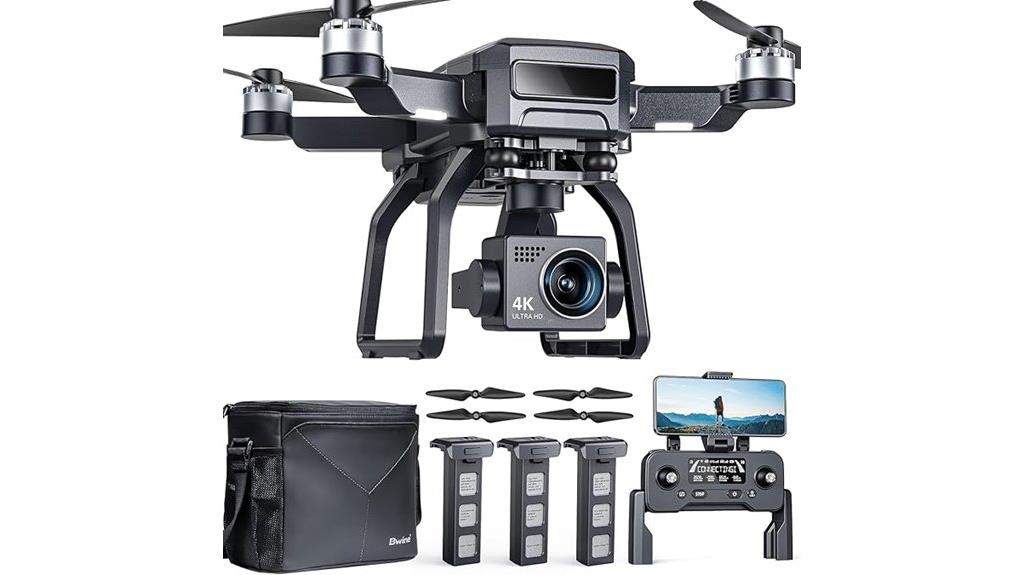
For aerial photographers and videographers seeking high-quality footage, the Bwine F7GB2 Pro Drone stands out with its 4K UHD camera, equipped with a 3-axis gimbal for ultra-smooth shots. The detachable camera features a 120° FOV lens and a larger CMOS sensor, delivering crisp, detailed images. With a 75-minute flight time powered by three intelligent batteries, it offers ample recording opportunities. Its advanced GPS system ensures safe, automatic return, even in high winds or at high altitudes up to 2000m. Compatible with a user-friendly app, it allows instant social media sharing and editing, making it a versatile choice for serious aerial content creators.
Best For: aerial photographers and videographers seeking high-quality, stable footage with extended flight time and advanced safety features.
Pros:
- 4K UHD camera with 3-axis gimbal ensures ultra-smooth, detailed footage
- Up to 75 minutes of flight time with three batteries provides extensive recording sessions
- Intelligent GPS system offers reliable autonomous return and multiple flight modes for safety and versatility
Cons:
- The drone’s size and weight may require careful handling and storage
- High-quality features may come at a higher price point compared to basic drones
- Dependence on app for social sharing and editing might limit usability without a compatible device
G11PRO 6K Drone with Camera for Adults
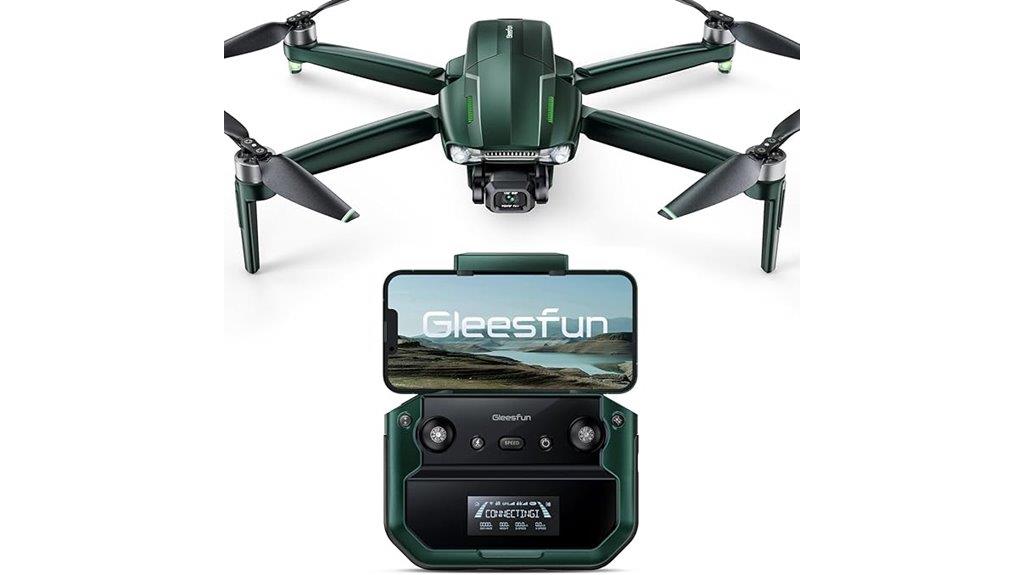
The G11PRO 6K Drone with Camera is an excellent choice for adults seeking professional-quality aerial photography and versatile flight modes. Its sleek design, FAA compliance, and portability make it ideal for both recreational and professional use. Equipped with a 3-axis brushless gimbal, it captures smooth, stable footage in various conditions. The 6K photo resolution and 4K/30fps video deliver vivid, detailed images, while the long-range transmission of up to 10,000 feet guarantees reliable control. With up to 70 minutes of flight time, intelligent modes like Follow Me and Waypoint Fly, and user-friendly controls, this drone offers impressive performance for serious aerial enthusiasts.
Best For: adult drone enthusiasts and professionals seeking high-quality aerial photography with versatile flight modes and long-range control.
Pros:
- Captures professional-grade 6K photos and 4K/30fps videos with a stabilized 3-axis brushless gimbal.
- Long-range transmission of up to 10,000 feet and up to 70 minutes of flight time for extended sessions.
- User-friendly controls and intelligent flight modes like Follow Me, Waypoint Fly, and Auto Return for easy operation.
Cons:
- Fast charging time of approximately 2.5 hours may require planning for extended flying sessions.
- The drone’s advanced features and setup might be overwhelming for complete beginners without prior experience.
- The price point may be higher compared to basic consumer drones, making it less accessible for casual users.
GPS Drone with Camera 4K, Foldable, 45 Min Flight

A GPS drone with 4K camera and foldable design stands out for outdoor enthusiasts who need reliable, long-lasting flight time. The HK33 offers an adjustable anti-shake camera with a wide-angle lens, capturing high-res images and smooth videos up to 2048x1088P. Its 45-minute flight time, powered by dual batteries, ensures extensive shooting sessions. With strong wind resistance and stable flight, it’s perfect for beginners. Advanced GPS functions like auto return, follow mode, and route planning add safety and ease. Its lightweight, foldable design makes it easy to carry, making it an ideal companion for outdoor adventures, travel, or aerial photography.
Best For: outdoor enthusiasts, beginners, and travelers seeking a lightweight, reliable drone with advanced GPS features and extended flight time for aerial photography and videography.
Pros:
- 45-minute flight time with dual batteries for extended shooting sessions
- 4K adjustable anti-shake camera with wide-angle lens for high-quality images and videos
- Compact, foldable design with lightweight construction under 250g for portability and no FAA registration needed
Cons:
- Limited to 2048x1088P video resolution, which may be lower than some professional drones
- Maximum transmission range of approximately 300 meters, potentially limiting long-distance flights
- Requires micro SD card or mobile device for storing media, adding extra accessories to carry
Drones with Camera for Adults 1080P HD Foldable Drone

If you’re looking for an easy-to-use drone that captures stunning 1080P HD footage, this foldable model is an excellent choice. It features an adjustable HD camera for clear aerial photos and videos, with real-time FPV streaming via the Velcase VGO app. The drone offers intuitive controls like one-key takeoff, landing, and altitude hold, making it perfect for beginners. Its foldable design and included accessories, such as propeller guards and spare blades, enhance portability and safety. With a flight time of up to 26 minutes, responsive controls, and safety features like overcurrent protection, it’s ideal for casual users seeking fun, reliable aerial photography.
Best For: beginners, kids, and casual drone enthusiasts seeking an easy-to-use, portable aerial photography drone with stable flight and fun features.
Pros:
- User-friendly controls with one-key takeoff/landing and altitude hold for easy flying.
- Foldable design and included accessories for enhanced portability and safety.
- 1080P HD adjustable camera with real-time FPV streaming for high-quality photos and videos.
Cons:
- Video streaming may be choppy, affecting live footage quality.
- Small size makes it susceptible to wind, which can impact outdoor stability.
- Limited advanced features, making it less suitable for professional or serious aerial filming.
2K HD FPV Drone with Camera for Beginners
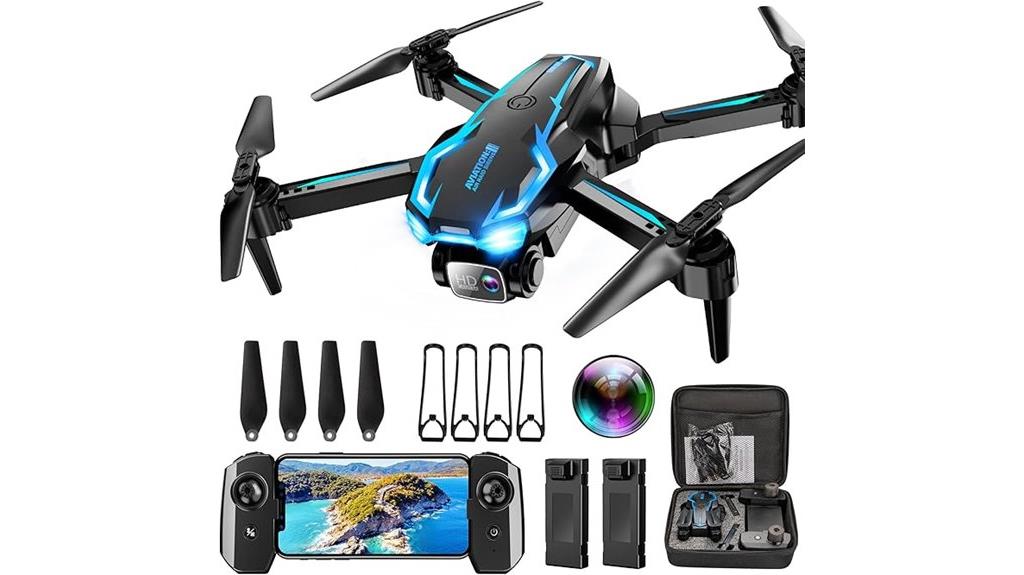
Beginners seeking an easy-to-fly drone will appreciate the K HD FPV Drone with Camera, thanks to its intuitive controls and beginner-friendly features. Its 2K HD camera with adjustable angles captures clear footage perfect for casual photography and social media sharing. Real-time FPV transmission to smartphones makes flying and sharing videos simple. Features like one-key takeoff and landing, Altitude Hold, and Optical Flow ensure stable flights, while headless mode and gravity sensing make steering effortless. Lightweight and foldable, it’s portable and travel-ready. With up to 20 minutes of flight time, durable build, and user-friendly controls, it’s ideal for newbies and hobbyists alike.
Best For: beginners, teens, and hobbyists looking for an easy-to-fly, portable drone with a good camera for casual aerial photography and social media sharing.
Pros:
- User-friendly controls with one-key takeoff/landing and headless mode, ideal for novices
- 2K HD adjustable camera and real-time FPV transmission enhance flying experience and content sharing
- Compact, foldable design with extra batteries and travel bag for portability and extended flight time
Cons:
- Flight performance may be limited in windy or adverse weather conditions due to lightweight construction
- Video feed has a minor delay, which could affect real-time piloting and framing
- Not suitable for professional-grade photography or videography, primarily designed for casual use
Potensic ATOM 2 Drone with 4K Camera and Fly More Combo
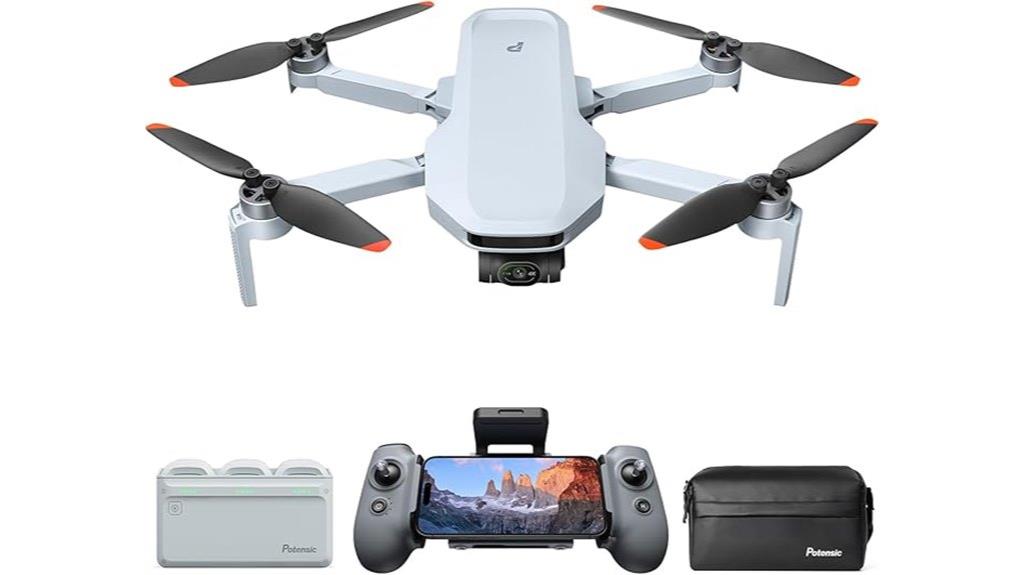
The Potensic ATOM 2 Drone with 4K Camera and Fly More Combo excels for aerial photographers seeking high-quality imaging combined with ease of use. It features a 48MP camera with a 1/2 Sony CMOS sensor, capable of capturing sharp HDR videos at 4K/30fps and 8K photos with detailed digital zoom and panoramic modes. Its stabilization gimbal guarantees smooth footage, even during fast movements. The drone offers up to 10 km control range, 30-minute flight time per battery, and smart features like object tracking and gesture controls. Compact and beginner-friendly, it’s perfect for capturing professional-quality images without the complexity of high-end drones.
Best For: aerial photography enthusiasts and beginners seeking high-quality 4K imaging, smart features, and portability in a user-friendly drone.
Pros:
- High-resolution 48MP photos and stable 4K HDR video recording with gimbal stabilization
- Long control range of up to 10 km and 30-minute flight time per battery for extended shoots
- Smart features like object tracking, gesture controls, and automated shooting modes
Cons:
- Limited vertical video resolution to 2.7K, which may affect some creative editing needs
- Sensitive to water exposure; not suitable for wet environments or saltwater conditions
- HDR footage can sometimes appear blown out, requiring careful adjustments during editing
New Version TFS20-L Lidar Sensor for Distance Measurement

Looking for a compact, high-precision lidar sensor that easily integrates into small drones? The TFS20-L is perfect. This lightweight module measures distances up to 20 meters with ±6cm accuracy, thanks to advanced dToF technology. Its tiny size—just 21×15×7.87mm—and weight of only 1.35g make it easy to install in tight spaces. It features versatile interfaces like UART and I2C, ensuring compatibility with platforms such as Raspberry Pi, Arduino, and Pixhawk. With low power consumption (≤0.35W), it’s ideal for continuous operation in indoor and outdoor environments, supporting drone applications like altitude hold, landing assistance, and obstacle avoidance.
Best For: DIY drone enthusiasts and engineers seeking a compact, high-precision lidar sensor for obstacle avoidance and altitude control in small-scale aerial and robotic applications.
Pros:
- Ultra-compact size and lightweight design for easy integration into tight spaces
- High-precision distance measurement up to 20 meters with ±6cm accuracy
- Versatile interfaces (UART, I2C) ensure broad compatibility with popular platforms like Raspberry Pi and Arduino
Cons:
- Limited measurement range beyond 20 meters, unsuitable for long-distance applications
- May require careful calibration for optimal performance in varying environmental conditions
- Slightly higher cost compared to basic ultrasonic sensors for similar short-range tasks
Drone with Camera, 2K HD FPV Drone with Brushless Motor
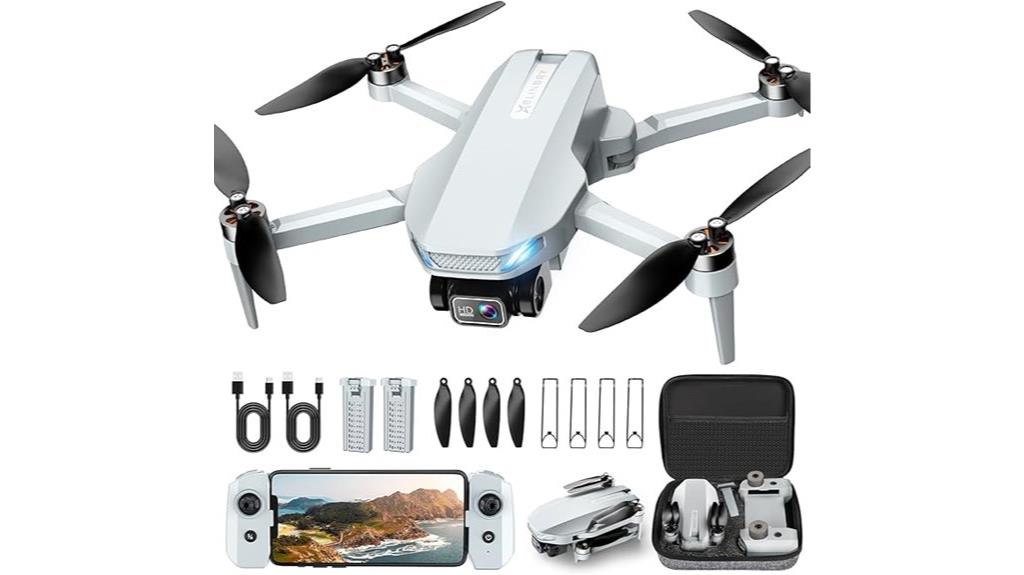
If you’re seeking a drone that combines high-quality imaging with ease of control, the 2K HD FPV drone with a brushless motor is an excellent choice. Its 90° electrically adjustable camera lens offers versatile perspectives, while built-in shock absorption guarantees stable footage. The 5GHz FPV transmission provides smooth, real-time video streaming, and footage can easily be shared via phone or SD card. With up to 32 minutes of flight time on two modular batteries, powerful brushless motors deliver smoother, quieter flights. Its foldable design makes it portable, and user-friendly controls like one-button takeoff and headless mode make it perfect for beginners and experienced flyers alike.
Best For: hobbyists and beginners seeking an easy-to-control drone with high-quality camera capabilities for outdoor and indoor aerial photography.
Pros:
- 2K HD camera with adjustable lens and shock absorption for stable, versatile footage
- Up to 32 minutes of flight time on dual modular batteries for extended flying sessions
- User-friendly features like one-button takeoff/landing and headless mode suitable for all skill levels
Cons:
- May require a compatible smartphone for full control via the BLINORY GO app
- Optimal performance primarily in open spaces; less suitable for densely populated or highly obstructed areas
- Slightly limited in advanced flight modes compared to professional-grade drones
DJI Mini 4K Drone with 4K UHD Camera
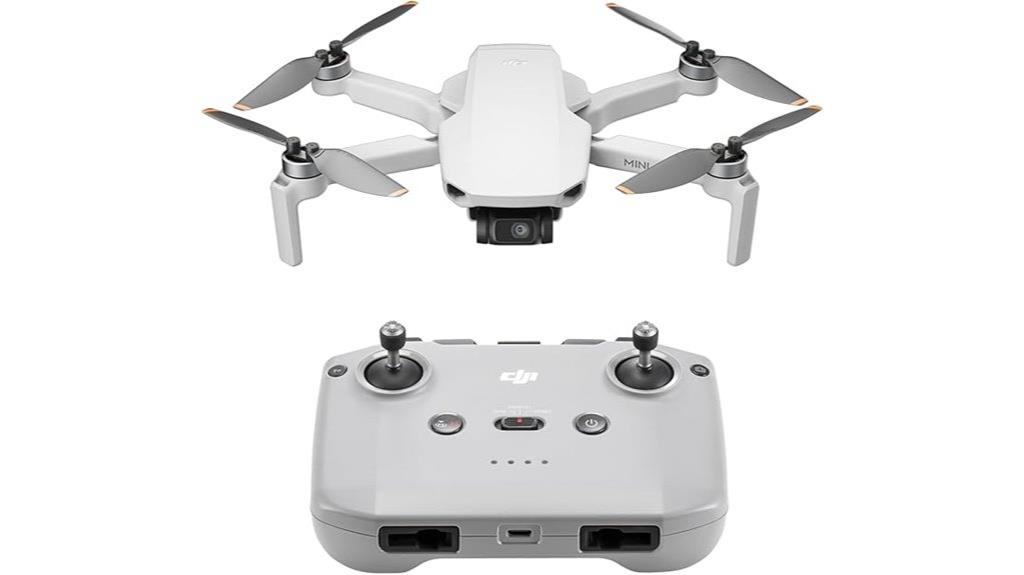
For hobbyists and beginners seeking a lightweight, easy-to-use drone, the DJI Mini 4K with its 4K UHD camera offers an ideal solution. Weighing less than 249 grams, it doesn’t require FAA registration or Remote ID in most regions, making it accessible and hassle-free. Its compact design is perfect for travel, with advanced lightweight materials ensuring durability. The drone features a 3-axis gimbal stabilizer for smooth footage, capturing stunning 4K videos and 12 MP photos. With up to 31 minutes of flight time, a 10 km transmission range, and user-friendly controls, it’s an excellent choice for those starting in aerial photography.
Best For: hobbyists and beginners looking for a lightweight, easy-to-operate drone for capturing smooth 4K videos and photos.
Pros:
- Extremely lightweight and portable, no FAA registration required in most regions
- Equipped with a 3-axis gimbal for stabilized, professional-quality footage
- Long flight time of approximately 31 minutes per battery and a 10 km transmission range
Cons:
- Lacks collision sensors, requiring careful flying to avoid obstacles
- Requires the DJI Fly app, which must be downloaded from the DJI website, not directly from app stores
- Limited to basic safety features without advanced obstacle avoidance or sensors
Drone with Camera, 1080P HD Foldable Drone with 2 Batteries and Carrying Case
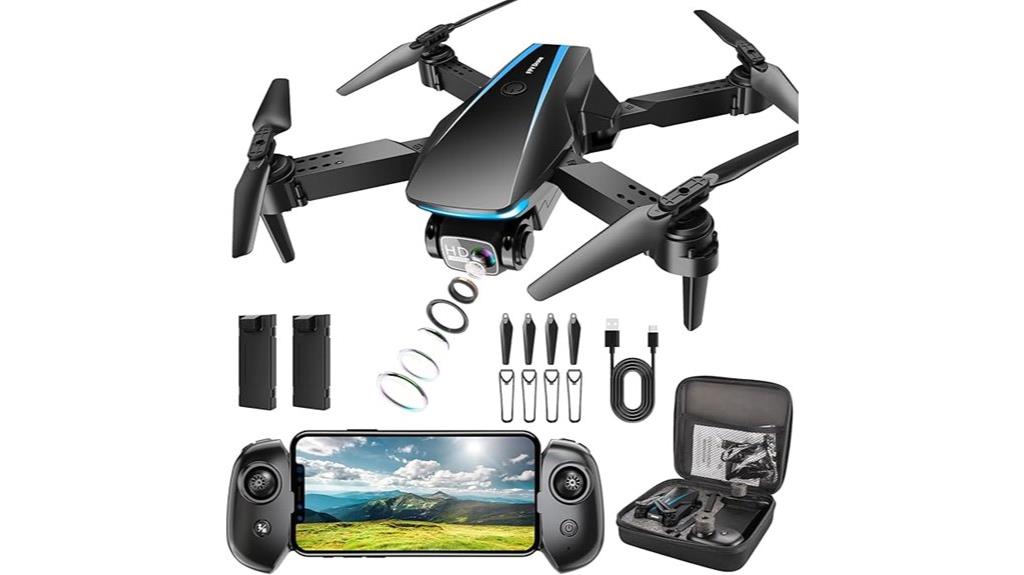
This foldable drone with a 1080P HD camera is perfect for beginners and casual enthusiasts who want easy-to-use, high-quality aerial footage. It offers multiple functions like trajectory flight, gravity control, 3D flips, headless mode, and gesture photo, all accessible via app or remote. The adjustable camera captures stable, clear images and videos thanks to the upgraded hover system and optical flow technology. Its foldable, lightweight design makes it portable, with a carrying case included. With two batteries providing up to 28 minutes of flight, simple controls, and safety features like return-to-home, this drone is ideal for capturing quality shots on outdoor adventures or casual flights.
Best For: casual photographers, beginners, and outdoor enthusiasts seeking an easy-to-operate, portable drone with high-quality camera features.
Pros:
- User-friendly controls with multiple flight modes suitable for all skill levels
- Compact, foldable design with included carrying case for effortless portability
- Equipped with two batteries offering up to 28 minutes of flight time for extended use
Cons:
- Limited to 1080P HD video quality, which may not satisfy professional videographers
- Requires smartphone app for full functionality, which might have compatibility issues on some devices
- Basic camera stabilization may not be sufficient for highly cinematic shots
Brushless Motor Drone with LCD Screen Remote Control
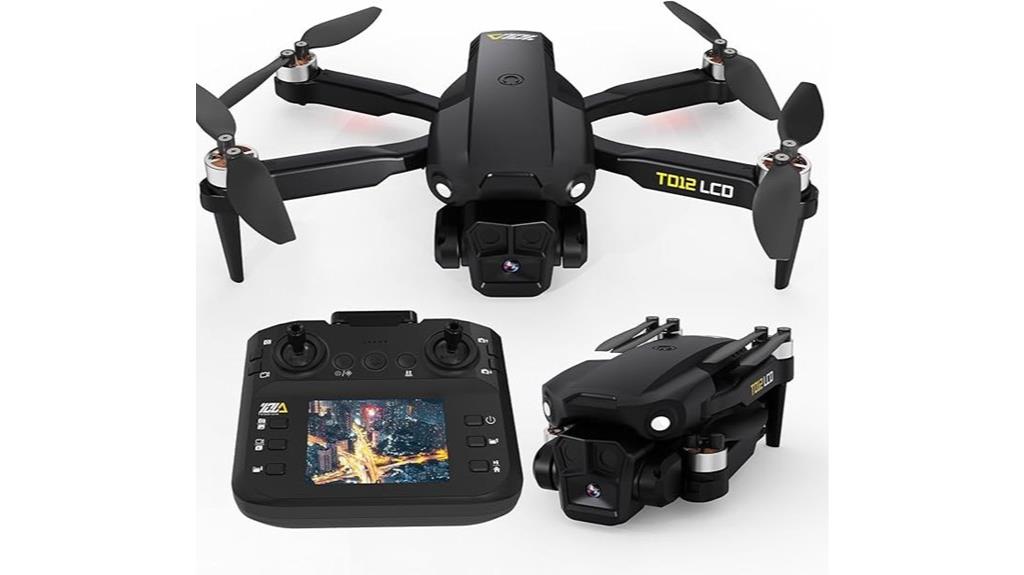
Are you looking for a drone that’s easy to control yet packed with advanced features? I found this foldable quadcopter perfect for both beginners and adults. It has powerful brushless motors for stable, efficient flight and comes with an LCD screen remote for real-time image transmission. The integrated camera supports SD cards up to 32GB, letting you capture high-def photos and videos easily. Its optical flow system ensures precise low-altitude hovering, while one-key takeoff/landing and headless mode make flying straightforward. Plus, with adjustable speed modes and about 20 minutes of flight time per charge, it’s versatile and user-friendly.
Best For: beginners and adults seeking an easy-to-fly, feature-rich drone for capturing high-quality photos and videos.
Pros:
- Foldable design for convenient portability and storage
- Equipped with stable brushless motors for efficient and quiet flight
- Integrated camera with real-time image transmission and SD card support
Cons:
- Limited flight time of approximately 20 minutes per charge
- May require some initial familiarization with advanced features
- Slightly larger size when unfolded might reduce compactness for travel
Drone with 1080P Camera, Foldable Quadcopter, 2 Batteries

If you’re looking for a portable drone that combines high-quality imaging with ease of use, the foldable quadcopter with a 1080P camera and two batteries is an excellent choice. It captures sharp, adjustable images and videos from a bird’s-eye view, perfect for selfies or inspecting hard-to-reach spots. With a flight time of up to 25 minutes, thanks to two batteries, you can enjoy extended flights. Its safety features—like propeller guards, emergency stop, and stable hover system—ensure a smooth experience. Designed for beginners, it offers multiple control modes, voice commands, and fun flying modes, making it versatile for indoor and outdoor adventures.
Best For: beginners and casual users seeking an easy-to-fly, portable drone with high-quality 1080P imaging for indoor and outdoor photography, inspection, or recreational flying.
Pros:
- Easy to operate with multiple control modes, voice commands, and beginner-friendly features
- Extended flight time of up to 25 minutes with two batteries, ensuring longer flying sessions
- Safe and stable hover system with propeller guards and safety features for smooth, worry-free flights
Cons:
- May have limited advanced features for professional or high-end drone users
- Slightly reduced image quality compared to higher-resolution cameras (1080P only)
- Performance could be affected by strong winds or outdoor conditions, requiring calm environments
Factors to Consider When Choosing Consumer Drones With Lidar
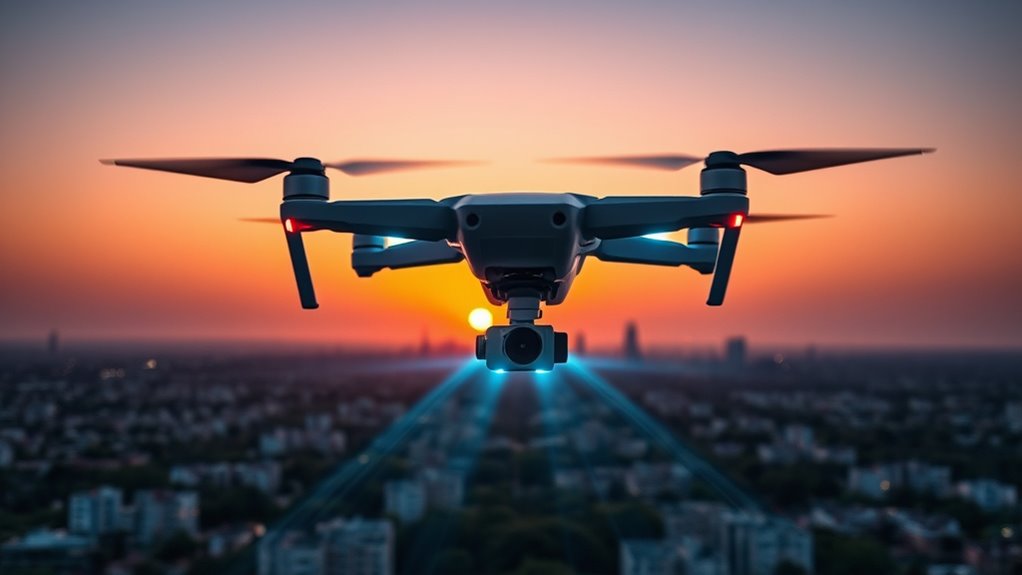
When choosing a consumer drone with Lidar, I focus on how well it works with my devices and whether it offers precise measurements within the needed range. I also consider flight time, battery life, and how portable the drone is for easy transport. Finally, I look at how straightforward it is to integrate the Lidar system into my workflow to guarantee smooth operation.
Compatibility With Devices
Choosing a consumer drone with Lidar requires careful attention to device compatibility to guarantee smooth operation and integration. I make sure the drone’s Lidar sensor interface matches my existing devices, whether it’s UART, I2C, or USB, to avoid connection issues. It’s also essential that the drone’s control system supports the communication protocols my hardware uses. I double-check that the software or SDK is compatible with my operating system, like Windows, Linux, or Raspberry Pi, especially if I plan to customize or analyze data. Additionally, I verify my device’s processing power and ports can handle the Lidar sensor effectively. Finally, I consider whether the drone supports third-party apps or development platforms to expand my data processing options. Compatibility is key for a seamless experience.
Measurement Accuracy and Range
Ensuring compatibility with my devices is just the beginning; I also need to contemplate how accurately and how far a drone’s LiDAR sensor can measure. Measurement accuracy typically ranges from ±2cm to ±6cm, depending on the model and environmental factors. The effective range varies from about 0.2 meters up to 20 meters, with some advanced models reaching farther. Several factors influence these measurements, including laser pulse frequency, beam divergence, and sensor resolution, which all impact precision. Environmental conditions like ambient light, surface reflectivity, and atmospheric particles can also affect reliability. Regular calibration and high-quality sensors are essential for maintaining consistent accuracy over time. When choosing a drone, balancing measurement range and precision is vital for ideal aerial mapping outcomes.
Flight Time and Battery
Longer flight times are essential for maximizing data collection with lidar-equipped drones, as they reduce the need for frequent recharging and allow for more extensive surveying sessions. Drones with 30 to 90-minute flight durations enable thorough coverage without interruptions. High-capacity batteries, like 3000mAh or more, are key to achieving these extended times. Keep in mind, environmental factors such as wind and temperature can affect battery life, potentially shortening flights. The ability to swap batteries or carry extra ones is a significant advantage, especially for professional mapping projects. Additionally, choosing drones with smart battery management systems helps maintain consistent performance and prolong battery health over multiple charges. Ultimately, better battery life translates to more efficient, cost-effective surveying operations.
Size and Portability
When selecting a consumer drone with lidar, size and portability are crucial factors that can considerably impact your outdoor experience. Smaller, foldable drones are easier to carry during outings and travel, making them ideal for on-the-go mapping. Lightweight models under 250 grams often avoid FAA registration, simplifying casual use. Many portable drones come with integrated carrying cases or bags, enabling quick setup and transport. The size also affects maneuverability; smaller drones can navigate tight spaces and perform precise measurements in confined environments. Conversely, larger drones with more robust lidar sensors tend to have longer flight times and greater stability but are less convenient for portability. Balancing size with your specific needs ensures a smoother, more efficient aerial mapping experience.
Ease of Integration
Choosing a consumer drone with lidar isn’t just about size; it also depends heavily on how easily the sensor integrates with your existing setup. Compatibility with hardware like Raspberry Pi, Arduino, or Pixhawk ensures smooth operation without extensive modifications. The sensor’s communication interfaces, such as UART or I2C, need to match the drone’s onboard systems for simple wiring and reliable data transfer. Firmware and software support, including SDKs or APIs, are crucial for customizing sensor functions and integrating them into flight algorithms. Additionally, the lidar’s physical size and weight must align with your drone’s payload capacity to maintain balanced flight. Finally, clear documentation and user-friendly setup procedures can greatly reduce troubleshooting, making the integration process faster and more straightforward for both beginners and experienced users.
Power Consumption Efficiency
Since power consumption directly impacts a drone’s flight time, selecting lidar sensors with low energy use is vital for maximizing operational efficiency. Low-power lidar sensors extend flight times by reducing energy drain, allowing for longer missions without frequent recharging. High efficiency modules also help keep the drone’s overall weight and size down, making them more compact and agile. Using energy-efficient circuitry, like pulse modulation and integrated power management, further conserves battery life. This enables continuous data collection at lower power levels, maintaining accuracy during extended flights. Choosing lidar systems optimized for low power consumption guarantees reliable performance over longer durations, which is essential for detailed aerial mapping and surveying tasks. Ultimately, power-efficient lidar contributes to more practical, cost-effective drone operations.
Environmental Suitability
Power efficiency remains essential for extending drone flight times, but environmental factors also play a key role in determining lidar performance. Drones with lidar work best outdoors in bright sunlight, as laser pulses can struggle with strong ambient light or reflective surfaces. They perform poorly in dusty, foggy, or rainy conditions because particulates scatter or absorb laser signals, reducing accuracy. Vegetation density and terrain complexity also matter; dense foliage can block laser reflections, while uneven terrain demands advanced sensors for precise mapping. Open, unobstructed spaces are ideal, since obstacles like buildings or trees can interfere with laser scanning. Additionally, wind and temperature fluctuations can destabilize the drone and impact lidar sensors, so evaluating weather conditions is crucial for reliable outdoor operation.
Price and Value
How do you determine if a drone with LiDAR offers good value for your money? First, consider whether the drone’s features match your needs. Higher-priced models often provide longer flight times, better range, and more advanced capabilities, which are essential for professional mapping. However, the overall value depends on balancing the cost against factors like accuracy, resolution, and ease of use. Budget-friendly options might save you money upfront but could lack range or detail, limiting their effectiveness. Don’t forget to factor in accessories like software, batteries, and cases, as these can add to the total investment. Also, evaluate durability, support, and usability—these elements impact long-term value and your return on investment.
Frequently Asked Questions
How Does Lidar Improve Aerial Mapping Accuracy in Drones?
Lidar substantially boosts aerial mapping accuracy because it uses laser pulses to measure distances precisely, even in challenging conditions like dense vegetation or low light. I’ve seen how drones equipped with lidar quickly generate detailed 3D models, capturing terrain and structures accurately. This technology minimizes errors common with traditional cameras, making mapping faster and more reliable—especially for complex landscapes or detailed inspections.
What Are the Main Differences Between Lidar-Equipped and Non-Lidar Drones?
The difference between lidar-equipped and non-lidar drones is like night and day. Lidar drones use laser scanning to create precise 3D maps, making them ideal for detailed terrain analysis. Non-lidar drones rely on cameras and photogrammetry, which can be less accurate and more affected by weather. I’ve found lidar’s ability to penetrate foliage and generate highly detailed data absolutely game-changing for aerial mapping.
How Long Do Lidar Sensors Typically Last on Consumer Drones?
You’re probably wondering how long lidar sensors last on consumer drones. I’ve found that most lidar sensors on these drones typically last between 200 to 500 hours of active use. However, this can vary depending on the manufacturer, maintenance, and usage conditions. Regular cleaning and careful handling can help extend their lifespan. Keep an eye on performance signs, and consider replacements when you notice accuracy dropping.
Are Lidar Drones Suitable for Indoor Mapping Applications?
You’re wondering if lidar drones are suitable for indoor mapping. I believe they’re quite effective because lidar can quickly create detailed 3D maps even in confined spaces. Unlike cameras, lidar isn’t affected by lighting conditions, making it ideal indoors. I’ve seen how these drones can navigate tight areas and produce accurate measurements, which is why I recommend them for indoor mapping projects.
What Safety Considerations Are Unique to Lidar-Enabled Consumer Drones?
When considering safety for lidar-enabled consumer drones, I focus on their unique features. Since lidar sensors emit laser pulses, I always verify they’re properly calibrated to avoid accidental eye exposure. I also keep a safe distance from people and obstacles, knowing lidar can operate in low light or darkness. Additionally, I regularly check for firmware updates to maintain reliable obstacle detection, ensuring my drone’s safe and effective operation.
Conclusion
Choosing the right drone with lidar is like finding the perfect compass for your aerial adventures. It guides you through the options, helping you navigate features and capabilities with confidence. Whether you’re mapping vast terrains or capturing stunning visuals, these drones are your trusted wings. So, take your time, weigh what matters most, and let your new drone elevate your perspective—your journey to the skies is just beginning.

